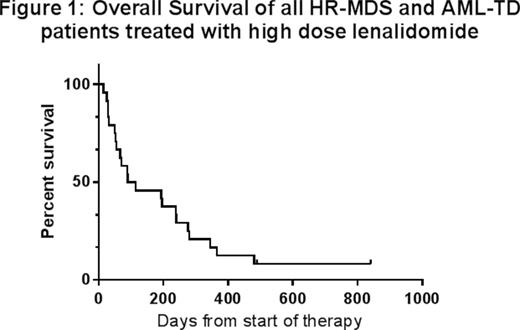Abstract
Background: Outcomes of patients (pts) with refractory and relapsed higher-risk myelodysplastic syndromes (HR-MDS) and acute myeloid leukemia with trilineage dysplasia (AML-TD) are dismal and therapeutic options are limited. Two phase 2 clinical trials reported clinical benefit using single agent high dose (50 mg) lenalidomide in elderly pts with untreated AML with and without deletion 5q (del5q), but this approach has not been formally studied in pts with AML-TD or HR-MDS who were refractory or relapsed following frontline therapy.
Methods: This single-arm phase II study conducted at Johns Hopkins University enrolled pts with HR-MDS defined as IPSS high and INT-2 and pts with AML-TD regardless of karyotype. Pts received 2 cycles of lenalidomide at 15 or 50 mg daily on days 1-28 out of 42-day cycles; the protocol was originally designed at 15 mg/day, but dose was increased to 50 mg/day upon publication of safety/efficacy data in AML. Up to 3 weeks off treatment were allowed for count recovery but dose reductions for hematologic toxicity were not allowed. Responses were evaluated using the International Working Group 2006 criteria (IWG-2006). Pts with stable disease were allowed to receive 2 additional cycles. Responding pts were allowed to continue to receive drug until progression. The primary endpoint was overall hematologic response rate (ORR) following administration of 2-4 cycles of lenalidomide. Toxicities were graded according to CTCAE 3.0 criteria. Overall survival (OS) was calculated from first dose of lenalidomide and estimated by Kaplan-Meier (KM) methods. The study protocol was approved by Johns Hopkins Institutional Review Board. The study was sponsored by Celgene Corporation.
Results: Twenty seven pts were enrolled between July 2009 and March 2014, of whom 9 received the 15 mg dose and 18 received the 50 mg dose. Median age was 72 years (range, 47-88 years); 76% were ≥65 years; 16 pts had HR-MDS and 11 had AML-TD. No pt had isolated del5q but 2 pts had del5q as part of complex karyotype; 41% had poor-risk karyotypes. Median bone marrow blast percentage was 15% for the entire cohort (range, 2-90%) and 40% for AML-TD pts. Median platelet count was 37×10⁹/L (range, 3-293×10⁹/L), and 63% of pts had platelet count of 50 or lower. Median white blood cell count was 2.4×10⁹/L (range, 0.5-6.4×10⁹/L) while median hemoglobin was 9.2 gm/dL (range, 6.7-14). Median number of prior regimens was 1 (range, 1-4). Median follow-up on study was 67 days (range, 9-245). Among the 9 pts who received 15 mg dose, 5 (55.6%) completed ≥2 cycles, none achieved an objective response, and none had grade 3 or 4 non-hematologic toxicity that was likely related to lenalidomide. Among the 18 pts treated at 50 mg dose, all had grade 3 or 4 non-hematologic toxicity, most commonly neutropenic infections, and only 7 pts (38.9%) completed ≥2 cycles of therapy. Among 18 pts treated on the 50 mg dose, ORR was 11% (both partial responses) and therefore the study was stopped due to futility. Both responders had AML-TD; one had normal karyotype and the other had monosomy 7. Overall, 30- and 60-day mortality rates were 14.8% and 29.6%, respectively. Median OS for the entire cohort [Figure 1] was 114 days (range, 15-841). Five pts (18.5%) survived ≥1 year; of those 1 pt got salvage low dose cytarabine; another underwent bone marrow transplantation, whereas the others chose supportive care alone.
Conclusions: High dose lenalidomide(50 mg daily) administered on a 28/42-day cycles in pts with relapsed/refractory HR-MDS or AML-TD is poorly tolerated and associated with signficant toxicity and minimal activity. Further exploration of high dose lenalidomide in pts with AML-TD and HR-MDS should probably employ an intermittent dosing schedule and focus on intensive chemotherapy-ineligible untreated pts with AML.
Off Label Use: Use of high dose lenalidomide for higher risk MDS and AML. Gore:Celgene: Consultancy, Honoraria, Research Funding.
Author notes
Asterisk with author names denotes non-ASH members.


This feature is available to Subscribers Only
Sign In or Create an Account Close Modal